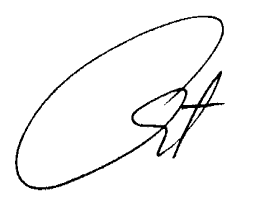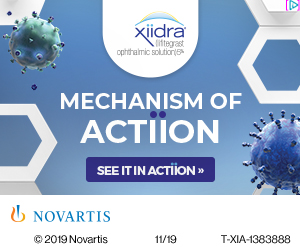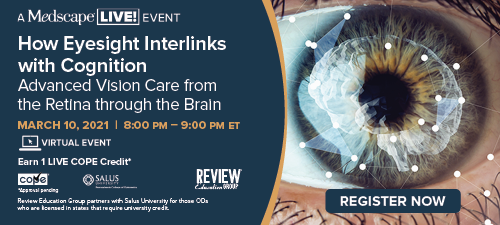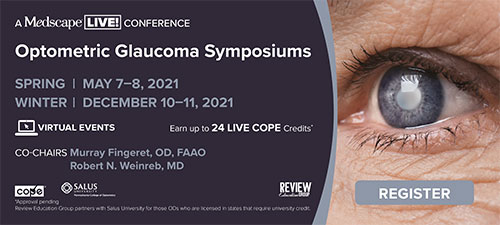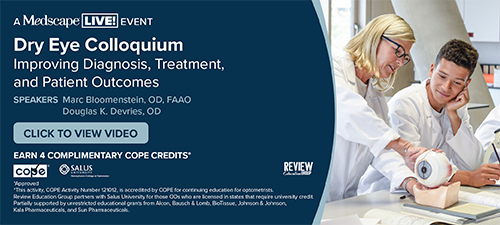
A
weekly e-journal by Art Epstein, OD, FAAO
Off the Cuff: An Open Letter to Ophthalmology
Over the past few years, despite the dogged determination of some in our respective professions to the contrary, optometry and ophthalmology have grown closer together. Advances in optometric education, the impact of COVID, the combined forces of technology, economics, government overreach and overregulation have made it increasingly apparent that optometry and ophthalmology are headed for a collaborative nexus.
|
|||||
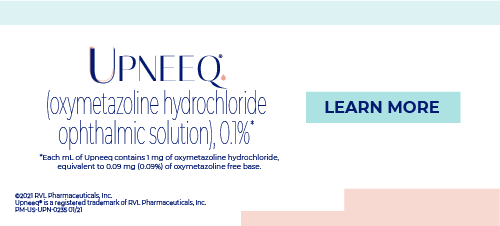 |
||
| Short-term Effects of COVID-19-Related Deferral of Intravitreal Injection Visits | ||||
In this cross-sectional, retrospective analysis of a single-provider outpatient clinic across multiple satellites, consecutive patients returning for intravitreal injections (IVIs) of anti-vascular endothelial growth factor or corticosteroids were identified as "delayed" or "undelayed" during a six-week study interval during the COVID-19 pandemic to determine secondary effects of the closure period on injection-based retina care and outcomes. A "delayed" encounter was defined as having a follow-up interval exceeding 33% of the recommended cycle. Patients seen for IVIs during the corresponding six-week interval a year previously were identified for study as pre-COVID-19 controls. Main outcome measures included best-corrected visual acuity (BCVA) and optical coherence tomography (OCT) assessment based on findings of intraretinal or subretinal fluid consistent with new or recurrent neovascular events. |
||||
SOURCE: Ashkenazy N, Goduni L, Smiddy WE. Short-term effects of COVID-19-related deferral of intravitreal injection visits. Clin Ophthalmol. 2021; Feb 3. [Epub ahead of print]. |
||||
 |
||
| Corneal Penetration of Low-dose Atropine Eye Drops | ||||
Major studies demonstrating the inhibition of myopia in children and juveniles by low-dose atropine eye drops provide little information on the manufacturing process and the exact composition of the atropine dilutions. However, corneal penetration might significantly vary depending on preservatives such as benzalkonium chloride (BAC) and the atropine concentration. Since there is a tradeoff between side effects, stability and optimal effects of atropine on myopia, it is important to gain better knowledge about intraocular atropine concentrations. Researchers performed an ex vivo study to determine corneal penetration for different formulations. Atropine drops (0.01%) of different formulations were obtained from pharmacies and applied to the cornea of freshly enucleated pig eyes. After 10 minutes, a sample of aqueous humor was taken, and atropine concentrations were determined following liquid-liquid extraction followed by high-performance liquid chromatography-tandem mass spectrometry (LC-MS/MS).
|
||||
| SOURCE: Austermann H, Schaeffel F, Mathis U, et al. Corneal penetration of low-dose atropine eye drops. J Clin Med. 2021; Feb 4;10(4):588. | ||||
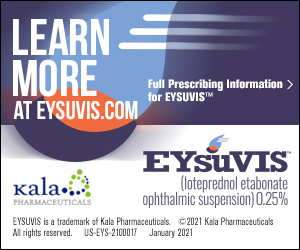 |
||
| Effect of Steroid Eye Drops After Trabeculectomy in Glaucoma Patients: a Keratograph Analysis | ||||
A total of 31 eyes of 31 glaucoma patients were studied to investigate the use of preoperative steroid drops in glaucoma patients undergoing trabeculectomy for ocular surface disease. Only glaucoma patients who had been using at least three topical intraocular pressure-lowering medications for longer than six months were included. All patients were treated with loteprednol etabonate ophthalmic suspension 0.5% four times per day for one week before trabeculectomy. Data from baseline (day of surgery) and the follow-up visit (two weeks after surgery) were included. All patients underwent a detailed ophthalmologic exam. Ocular surface disease was evaluated using the Ocular Surface Disease Index questionnaire and clinical measures, including tear breakup time, conjunctival hyperemia, and biomicroscopy to detect the presence or absence of keratitis. Ocular Surface Disease Index scores greater than 13 indicated a clinically relevant presence of ocular surface disease. In addition, all patients underwent keratograph analysis. The comparison of ocular surface disease before and after trabeculectomy was assessed using a paired test. The mean age of the glaucoma patients was 69.90 ± 10.77 years. The average visual acuity was 0.40 ± 0.34 logMAR. The overall Ocular Surface Disease Index prevalence rate was 27.20 ± 17.56 units. Clinical assessment revealed no significant difference in bulbar redness, breakup time or keratitis before and after surgery. Keratograph analysis showed that the only two parameters that were significantly different before and after trabeculectomy were the bulbar redness by keratograph (BR-K) and the average noninvasive tear breakup time. Patients presented more conjunctival hyperemia and shorter noninvasive tear breakup time after trabeculectomy compared with before surgery. |
||||
| SOURCE: Fares NT, Portela RC, Machado LF, et al. Effect of steroid eye drops after trabeculectomy in glaucoma patients: a keratograph analysis. Arq Bras Oftalmol. 2021; Feb 3. [Epub ahead of print]. | ||||
 |
||
| News & Notes | |||||||||||||||||||||||||||||||||||||||||||
| Prevent Blindness to Hold Annual Eyes on Capitol Hill Advocacy Event Prevent Blindness will be holding its sixteenth annual Eyes on Capitol Hill advocacy event virtually Feb. 24 and 25. The program brings together patients, caregivers, public health workers and medical professionals with their elected officials to educate lawmakers and their staff on vision issues, including equitable access to quality eye care, health disparities in the prevalence of vision disorders, and the importance of sight-saving research and surveillance. Learn more.
|
|||||||||||||||||||||||||||||||||||||||||||
| Euclid Systems Announces Expansion of Leadership Team Euclid Systems, a global provider of advanced orthokeratology and proactive myopia management, expanded of its leadership team over the last six months, to include the following individuals: • Barry A. Rhein, vice president of manufacturing, was most recently vice president of global supply chain at Bausch + Lomb • Guanrong (Gary) Ding, vice president of sales, China, formerly served as commercial director at Abbott Medical Optics and Johnson & Johnson Surgical Vision • Jackson Lau, OD, FAAO, FSLS, manager of clinical and scientific affairs, is a cornea and contact lens residency-trained optometrist with clinical research experience • Jim Rackley, senior director, product engineering, previously served in the role of continuous improvement manager at Zimmer Biomet • Linda Chang, chief financial officer, was the chief financial and chief operating officer of Science and Medicine Group • Nitin Jain joined in August 2020 as global vice president of marketing after serving as senior director of Johnson & Johnson Vision, where he led the global Acuvue contact lens portfolio marketing team • Zhang (Neo) Zhixang, vice president of marketing, China, joined from Essilor, where he was senior marketing director |
|||||||||||||||||||||||||||||||||||||||||||
|
|||||||||||||||||||||||||||||||||||||||||||
|
Optometric Physician™ (OP) newsletter is owned and published by Dr. Arthur Epstein. It is distributed by the Review Group, a Division of Jobson Medical Information LLC (JMI), 19 Campus Boulevard, Newtown Square, PA 19073. HOW TO ADVERTISE |

